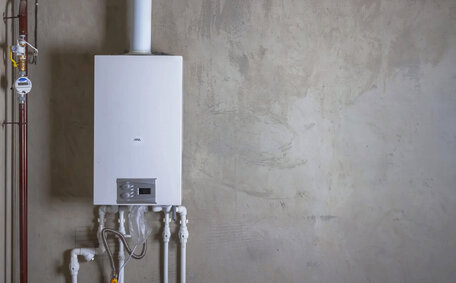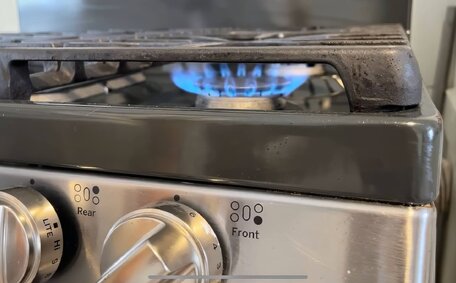Welcome homeowners! Detecting an unusual gas odour or identifying your gas meter’s location is crucial for safety. This guide outlines how to shut off your gas supply efficiently.
It’s critical for homeowners to know how to turn off your gas in an emergency. This guide covers locating the meter box, using the shutoff valve, relighting appliances, and managing your gas supply.
With over a decade of experience, you can trust our local Sydney plumbers to provide these instructions in line with regulations.
By the end of this guide, you’ll be well-equipped to manage a gas leak emergency or perform routine checks on your gas meter controls. Understanding how to handle your home’s gas supply is essential - let’s get started!
Identifying The Gas Meter and Shut-Off Valve
Before adjusting any gas-reliant appliances, always pinpoint the location of your gas meter and shut-off valve. Generally positioned outside your home, near the front boundary or along a side pathway, these fixtures can be inconspicuously situated.
The shut-off valve, typically attached to the meter with a gas pipe, can be rotated 90 degrees to the 'off’ position.
It’s essential to be familiar with your gas meter and how do i turn the valve tap during regular use to respond quickly in a gas leak emergency. A meter key, used for operating the valve, is typically found hanging inside the locked box.
Confident and safe access to these components enables you to control the gas flow through your home’s main supply pipe. We recommend Glenhaven homeowners familiarise themselves with the locations related to their gas appliances.
Locating The Gas Meter
To locate your gas meter, begin by inspecting the front exterior wall of your home, as meters are commonly found here for convenient access.
Focus your search near the front boundary line. Check along any side passages or driveways as well. The metre, which you can turn off using a metre key, is typically a grey metal box around 60cm tall.
If there’s no sign of the gas meter, search other areas of your property or the back wall, ensuring all sources are turned off first. Trace any exterior pipework back to where the gas service begins, looking both high and low since meters can be installed at various heights.
Look for the shut-off valve tap extending from the meter box, often around 1 metre above ground, as part of your shutdown preparation. After finding the meter, follow the connected gas pipes and note where the gas supply can be switched off. Know its position in case of a gas emergency.
Accessing The Gas Shut-Off Valve
To access the gas shut-off valve, you first need to open your gas metre box, usually locked with a metre key.
Be cautious opening the meter box, especially when disconnecting gas. Avoid open flames or smoking, or seek assistance from a licensed gas fitter. The shutoff valve, typically a tap-like attachment on the meter, has a handle that rotates 90 degrees. Turning this handle perpendicular to the gas pipe stops the gas flow into your property’s lines.
Certain older gas system valves may require a specialised tool for operation, as they are not designed for manual turning.
Test your shut-off valve regularly to ensure it operates smoothly during emergencies. Leave tasks such as disabling the main gas supply at the streetside valve to the professionals from your licensed gas distribution company, rather than attempting it yourself.
When approaching the meter and its fittings, handle with care and avoid forcing any components. In case of uncertainty or damage to the shut-off valve or meter, promptly contact your licensed gas provider for guidance and repairs before restoring supply.
Pre-Safety Checks Before Turning Off Gas
Conduct safety checks on your appliances before turning off the gas supply, including the water heater. Switch off all gas appliances, then close the appliance taps located near each device. Check that all oven and cooktop controls are off, aligning with the pilot settings of your appliances.
This stops gas flow beyond gas shutoff valves.
Reconfirm that all appliance pilot lights are extinguished before shutting off the main gas supply. For locating your home’s gas meter box and handling the gas appliance supply valve, review the previous guidelines provided.
Once appliances are confirmed off and cool, carefully open the metre box and turn the shutoff valve 90 degrees into the off position to isolate the off gas supply line your property needs and stop all gas flow into your property.
Procedure to Shut Off Your Gas Supply
Adhere to these step-by-step instructions to ensure a safe shutdown of your gas supply:
- Ensure all gas appliances like gas stoves, hot water systems and room heaters are switched off. Turn oven and cooktop knobs to the 'off’ position.
- Locate the gas taps adjacent to each appliance and turn them off to stop gas flow beyond the main shutoff valve.
- Verify that any pilot lights on gas appliances are fully extinguished and allow appliances to cool.
- Retrieve your gas metre key and carefully open the locked metal meter box on the exterior of your home.
- Locate the shut off valve pipe protruding from the metre to stop flow gas when necessary. Use the instructional tips on valve usually and how turn off procedures work when using the metre key to loosen the valve.
- Turn the shutoff valve 90 degrees so that the handle is perpendicular to the pipe to stop all gas flow into your property.
With the main shutoff valve closed, gas supply is safely halted. Contact Glenhaven Plumbing for assistance with any gas equipment issues or for restoring supply after repairs are made.
Step-by-Step Safe Gas Shutdown Checklist
Use this straightforward step-by-step checklist to safely disable your gas supply:
- Switch off all gas appliances like stoves, hot water systems and heaters. Turn knobs to the ‘off’ position.
- Locate and turn the gas supply valve off behind each appliance to stop flow beyond the main valve.
- Check that all pilot lights are out and appliances have cooled.
- Use your metre key to open the locked gas metre box on the exterior wall.
- Find the shutoff valve pipe inside the box. Use the metre key to loosen the valve if needed.
- Carefully turn the shutoff valve 90 degrees so the handle sits perpendicular to the pipe.
Once the main shutoff valve is closed, your internal gas supply is securely turned off. Reach out to our Glenhaven plumbers for help in restoring your supply after necessary repairs.
Relighting Appliances After Gas Interruption
Once the gas supply is restored, safely relight your appliances. Start by confirming the main gas shut-off valve is on, and all individual appliance taps are open.
Check manufacturer instructions for specifics on relighting each appliance correctly, especially when turn procedures are not explicitly stated. Things to note when relighting:
- Allow time for air pockets to be purged from gas lines before attempting to relight pilots
- Make sure gas appliance valves, switches and controls are turned to the ‘off’ position before relighting
- Push control knobs in while turning to release gas flows to pilots
- Hold lighters or ignition sources near pilots while triggering igniters
- Keep holding pilots on for 30 seconds to warm thermocouples for your hot appliances before releasing
- Slowly turn on appliance controls once pilots remain lit
If you have any difficulty relighting appliance pilots or notice your hot water system operating inconsistently afterwards, it’s safe to call a licenced professional like Glenhaven Plumbing to check for underlying issues.
Understanding Your Gas Meter and ECV
Your gas meter, a crucial device located outside your home, records your household’s natural gas consumption. Enclosed within a locked casing, it features a dial or digital display indicating your usage.
Connected to your gas meter is the emergency control valve (ECV), a shut-off tap that ceases all gas flow to your property’s supply lines, enabling rapid disconnection by gas providers or emergency services in hazardous situations.
Regular checks of your gas meter and appliances are beneficial to monitor usage. Understanding the function of your meter and ECV helps ensure safe usage in emergencies. Never tamper with these devices – always seek a licensed professional.
Maintenance and Accessibility
Homeowners are responsible for keeping their gas meter and shut-off valve clear, accessible, and well-maintained. Ensure no vegetation, structures, or other obstructions impede access for technicians who may need to service or check for leaks.
Ensure the gas meter and shut-off valve are easily visible. Periodically, softly test the shut-off valves with meter keys to maintain their smooth operation.
If valves are stiff, don’t force them – instead, contact your gas provider for guidance. Also, be sure to safeguard meter boxes from any potential damage during yard work or general maintenance.
By keeping metres, valves and service pipe connections maintained properly, you avoid potentially hazardous gas leaks. This allows emergency crews to quickly shut off and reconnect gas supply as needed. Check in with Glenhaven Plumbing if you ever have concerns about gas equipment integrity on your property.
Dealing With Gas Leaks and Emergencies
If you detect a gas leak or smell gas inside your home and cannot address it immediately, don’t attempt to turn off the gas yourself. Take these urgent steps and remember to contact gas services:
- Avoid using any electronics, turning light switches on or off, or lighting matches/candles
- Open doors and windows to ventilate rooms
- Evacuate everyone from the property to a safe outdoor area
- Call 000 immediately to request emergency gas technicians
- Alert your gas provider once outside to cut off supply
Trying to find and turn off your gas shutoff valve during a leak risks making more sparks to ignite the gas. Keep our emergency plumbers at Glenhaven Plumbing’s number handy to request urgent assistance if needed.
Leave it to trained personnel. Have everyone gather safely away from the home until given the all-clear.
Legal Aspects and Responsibilities
Homeowners have legal obligations concerning gas infrastructure. According to Australian standards, you must ensure easy access to, as well as the integrity and safety of the gas meter, shut-off valve, and service pipe.
It is your responsibility to arrange repairs if the gas metre or piping is damaged. Never attempt DIY repairs. Contact your gas distribution company to fix metre issues, and a licenced gas fitter like Glenhaven Plumbing if pipes or appliances need servicing.
Tampering with gas infrastructure without proper qualifications is extremely hazardous and illegal.
In case of a suspected gas leak, it’s imperative to evacuate and call emergency services on 000 without delay.
Fines can apply for obstructing gas metre access. Keep the shut-off valve and box clear for technicians. If planning landscaping or building works around existing gas equipment, permits from relevant authorities are needed beforehand.
For detailed gas safety guidelines, consult the NSW Department of Planning and Environment. Adherence to these guidelines helps prevent supply disruptions and expensive repairs. If in doubt about safely reactivating your gas, seek advice from qualified professionals like Glenhaven Plumbing.
Tips For Safe Gas Management
Homeowners can take straightforward preventative measures to safely manage their property’s gas supply:
- Conduct regular visual checks along the gas metre, pipes and other fittings for potential leaks or damage
- Test appliance shutoff valves every 6 months to ensure smooth operation when needed
- Keep the emergency control valve and metre box clear of obstructions for accessibility
- Never attempt DIY repairs on gas systems - always call qualified gas technicians
- Install and routinely check smoke alarms and gas detectors for alerts
- Know how and when to safely turn off gas supply in an emergency
- Prominently display emergency phone numbers, including Glenhaven Plumbing
Proactive gas safety measures mitigate risks in your Glenhaven residence. Plus, our seasoned local plumbers are at your service 24/7 for any gas-related concerns.





